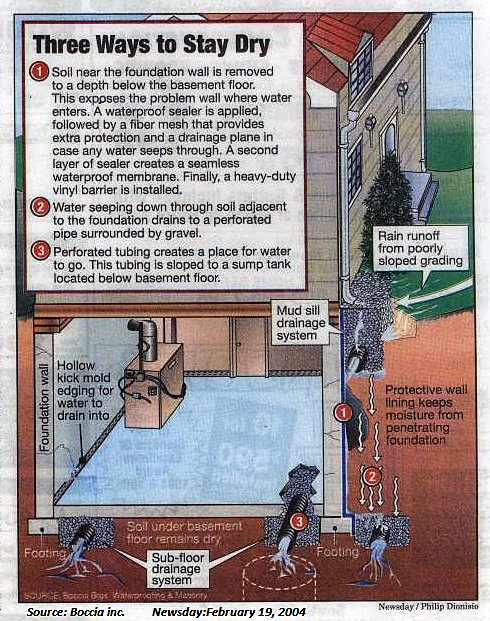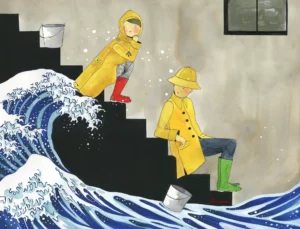Boccia Inc. Waterproofing Welcomes Fourth Generation:
Michael Boccia Joins to Uphold 70-Year Family Legacy as Waterproofing Specialists

Garden City Park, NY September 30, 2024 – BOCCIA Inc., Long Island’s leader in waterproofing services, proudly announces the addition of another engineer, Michael Boccia, to its staff. Michael represents the fourth generation of the Boccia family and will play a critical role in the company’s continued growth and development.
“I am delighted to announce that my son, Michael Boccia, will be joining our team at Boccia Inc. – Waterproofing and Masonry Specialists” said Vincent Boccia of Boccia Inc. “He represents the fourth generation of our family to serve the Long Island region with these essential services – following the footsteps of his great-grandfather, grandfather, and myself and my brothers.”
Michael brings a wealth of experience and expertise to the company through his years working alongside his father and grandfather learning the family trade of waterproofing and masonry. After earning his civil engineering degree at Villanova University, Michael worked for two international construction and consulting firms, Skanska and KPMG, where he was a key team member on major renovation projects including waterproofing at the Metropolitan Museum of Art. Currently he is pursuing his MBA as well as his New York State Professional Engineering (PE) license.
“As you can imagine, this is a moment of immense pride for me,” said Michael Boccia. “I am very grateful for the opportunity to carry on the vision of my grandfather, who arrived in this country from southern Italy at the age of 17 with no money or formal education to his name. As we face a climate of increasingly severe storm events, I am eager to continue BOCCIA’s time-tested legacy of serving New York with our premier waterproofing services.
About BOCCIA, Inc.:
BOCCIA, Inc. has been providing waterproofing and masonry restoration services since 1955. The experts at BOCCIA have accumulated a wealth of experience and expertise through their successful completion of thousands of residential and commercial projects across Nassau and Suffolk Counties and Queens. For more information, visit bocciabros.com.
Boccia Brothers Waterproofing In the New York Times
Holding Back the Floodwaters
Homeowners who faced flooded basements after Hurricane Ida are pondering how to deal with the possibility of fiercer and more frequent storms.
By Ronda Kaysen
Sept. 24, 2021
How do you keep the water out when it seems unstoppable? That is the question that keeps Carrie Moore glued to her phone whenever it rains, scanning weather radar apps to try to determine whether the basement of her Sunset Park rowhouse will flood.
It’s why sandbags now line her back door, and why she and her husband, Ryan Moore, 42, stayed up until 4 a.m. the night Hurricane Ida dumped a historic amount of rain on New York City. They spent the next night and early morning bucketing out sewage and storm water that had overflowed from the basement toilet and shower, rushed in through the sump pump, and seeped in through the foundation.
Despite the efforts, their finished basement filled with a foot of water.
“With the intensity of rains that we’ve been getting, it’s progressively getting worse, and so flooding just seems to be a regular occurrence,” said Ms. Moore, 42, an architect and the president of the 37th Street Block Association, which includes the homes between Fourth and Fifth Avenues. “I know I can’t win when it comes to water coming into our house. The water is going to win.”
Ms. Moore blames a sewer main on her block for the backups that have damaged her home and many others. Until Ida, the Moores, who have owned their house for five years, had been able to limit the sewage overflows to the basement bathroom, even as storms became stronger and more frequent. But now, as they rip out drywall and pull up their ceramic tile floors in the main living area of the basement, they’re grappling with a question shared by many across the region: What, if anything, can they do to keep this from happening again?
Despite the damage done, their block did not experience the worst flooding in the city. The storm killed scores of people in the Northeast, including more than a dozen New Yorkers, most trapped in basement apartments. Still, several basements on Ms. Moore’s block flooded with two to three feet of sewage water, costing those homeowners tens of thousands of dollars in cleanup and repair costs.
As their basements dry out, homeowners like the ones on this block of 37th Street in Brooklyn are coming to grips with a new reality. They are living in homes built when sea levels were lower, in communities with aging infrastructure and storm drainage systems ill-equipped to absorb the volume of water that comes with a rapidly changing climate. As the region braces for wetter, stronger storms, homeowners are paying to shore up basements that are at the mercy of municipal sewage systems that weren’t built for this type of onslaught.
Fixes aren’t cheap or simple. Waterproofing a home with French drains and a sump pump can cost, on average, $10,000 to $20,000, with no guarantee that the improvements will work under extreme conditions. More aggressive solutions mean spending more money. Do you get a second sump pump? Do you excavate and seal the exterior of the foundation? Do you throw up your hands and move?
Waterproofing companies have been overwhelmed with calls from frantic homeowners. Some say they are booked two to four months out, and the calls haven’t waned in the weeks since the storm.
“This is unprecedented. This is worse than Hurricane Sandy, the volume of calls we’ve been getting,” said Vincent Boccia, a third generation owner of Boccia, a waterproofing and masonry company that serves New York City and Long Island. In the past, a homeowner “might have said, ‘OK, I can manage this by mopping it up here and there.’ Now you’re not mopping it up anymore — you need pumps, and it’s not once every three years, it’s two times a year, three times a year.”
Home waterproofing solutions work by adding drainage and pumps that keep water flowing away from a house. But a homeowner cannot control how the water moves down the street or whether it flows properly underground.
“Storm water management in an urban setting like New York City is complicated,” said Edward Timbers, a spokesman for the city’s Department of Environmental Protection, in an email.
According to Mr. Timbers, the number of sewer backups in the city has fallen 66 percent over the past decade “through programmatic cleaning and aggressive responses to 311 reports.”
Among the calls to 311 were ones from residents of 37th Street in August, prompting the city to clear clogs in the sewer near the bottom of the block, and eventually to repair a break — work that finished on Sept. 3, two days after Ida drenched the city. Mr. Timbers suggested homeowners install check valves on the sewer lines, which can keep water from backing up into a home.
Since Hurricane Sandy in 2012, the city has invested $20 billion in a climate resiliency plan that includes storm water management. Yet the work completed so far could not absorb the volume of rain that fell on the city on Sept. 1 in a record amount of time.
On that night, Lois Aronow, who lives on the same block of 37th Street as Ms. Moore, watched as a waterfall poured over a concrete wall surrounding a Metropolitan Transportation Authority bus depot on Fifth Avenue. In videos she recorded, water can be seen spewing over the wall and out of drain holes. The basement of her three-bedroom rowhouse flooded with two feet of water, destroying a third of her living space. “I know it’ll happen again,” said Ms. Aronow, 62, a potter, who has rented the house for five years.
Ms. Aronow’s landlord hired contractors to remediate the damage and restore the property. But she worries about the long term. “It’s traumatic. How do you process it?” she said. “You can move to a high-rise, I suppose, but moving is not without its problems, either.”
Ms. Moore is reluctant to refinish or waterproof her basement until she can be convinced that the sewer problem has been adequately addressed. The check valve the previous owner had installed broke during Hurricane Henri, in late August. Replacing it could cost $5,000, she estimates. And restoring her basement to its previous condition could cost $30,000. Her homeowner insurance policy only provides for $5,000 in coverage for damage from sewer backups.
Ms. Moore worries that the city’s sewer fixes at the bottom of the block will not solve problems for her, since her home is at the top of the block. But according to Mr. Timbers, the repairs should resolve problems all along the street, and city engineers inspected the sewer after Hurricane Ida and found it to be working properly.
But Ms. Moore is not reassured. “You think of your home as this safe place where it’s yours and you’re invested in it,” she said. “Now that this has happened, knowing how bad it can get in our house, I think about our home completely differently. I just feel like we are at risk of our own property being damaged. All of our things. I can never be OK when it starts raining.”
Boccia Brothers Waterproofing In the Long Island News

By Gary Dymski
No sooner did I step through the doorway of the tool rental department at The Home Depot in South Setauket than the man behind the counter said: “If you’re looking for submersible pumps, we’re all out.”
This was a couple of weeks ago, when rainstorms and melting snow deposited water into many Long Island basements. Tool rental centers were deluged with customers looking to pump out their basements. “It was crazy here,” said Ed Mondini, owner of Gold Star Rental in Centereach. “Pumps were coming and going pretty quick. As fast as people returned them, we sent them out again.”
Perhaps my help- me look prompted the counterman’s assumption that I, too, was knee-deep in water. My trip to Home Depot only involved a search for kitchen cabinet hardware – the tool-rental section was nothing more than a shortcut.
My basement is dry – in fact, it has never flooded. Others aren’t so lucky.
For those homeowners seeing Noah in their nightmares, there’s hope. Portable submersible pumps, which can be rented for about $15 for eight hours, offer a temporary reprieve. Such pumps can remove water quickly – as much as 3,200 gallons an hour. That’s enough to flood a 12-by-12-foot room to nearly 3 feet. But obviously, these pumps are stopgap measures. Unless the source of the water is eliminated, the basement is sure to get wet again.
Keeping a basement dry during periods of heavy rain could be as simple as inspecting your roofing system: Roof water can leak because of old, cracked and missing shingles, or it can seep behind above-ground walls because of sagging gutters and missing downspouts. So much water can collect around the foundation that it leads to basement flooding.
Basements also can get wet because of the grade around the foundation. Soil should be graded to slope away from foundation walls. But don’t build the slope so high that it covers the wall entirely; a minimum of 6 inches should be exposed.
Despite all these efforts, water can still invade.
“Basements are not built to be waterproof, that’s really the bottom line,” says Vincent Boccia, one of the brothers in Boccia Brothers, a Garden City Park company that has handled basement water problems since 1955. One of the major factors, he says, is soil.
Foundations surrounded by clay soil are more likely to have leaks than those surrounded by sand or loamy soil. That’s because clay holds moisture, causing a pressure buildup. When this happens, water is forced into foundation cracks and joints by hydrostatic pressure. Sandy soil – like mine – or gravel-filled soil allows water to drain more freely, reducing the chance for hydrostatic pressure.
The long-term solution most likely is a professionally installed basement drainage system. Such systems are applied to the exterior of one wall or around the interior of the foundation wall where it meets the basement slab.
Waterproofing a single exterior foundation wall from the outside can be expensive – as much as $5,000 per wall. Soil must be excavated to expose the entire foundation wall. Then a waterproof coating is applied to the wall. A perforated pipe is placed in a bed of gravel at the bottom of the wall. Water collects in this pipe and is slowly dispersed into the soil, reducing hydrostatic pressure.

A more reliable process, Boccia says, is a subfloor drainage system, in which the section of the interior basement floor that butts up against the foundation wall is cut away. Soil is removed, then replaced with a perforated plastic pipe in an envelope of gravel. The pipe runs around the edge of the wall and floor to an automatic sump pump. Pipe and gravel are covered with concrete, so when hydrostatic pressure forces water through the foundation or slab, it is collected in the pipe, then drains to the sump pump. A subfloor system can cost between $3,000 and $5,000, depending on the size of your house.
If you’re building a new home, figure about half the cost. Many of the calls the Boccia Brothers fielded during the heavy rains earlier this month came from homeowners who were dealing with wet basements for the first time.
“This is the first time in the six or seven years they’ve lived in their homes that they’ve had water,” Joe Boccia said.
It may not be the last time. Spring thaws could mean even more wet basements across Long Island.





